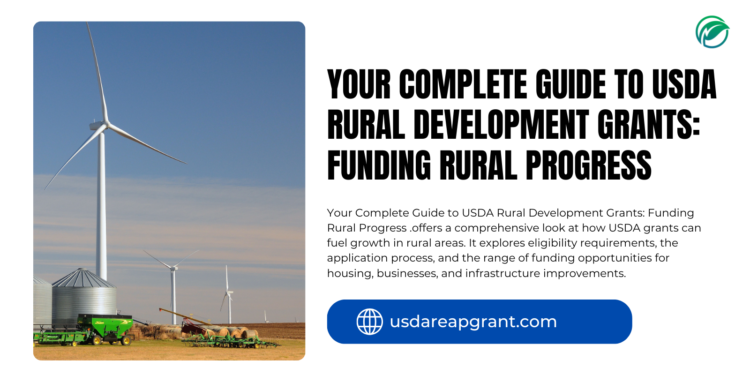Are you looking for financial assistance to support your rural development projects? The USDA Rural Development Grants provide invaluable resources for individuals, businesses, and organizations aiming to enhance the quality of life in rural areas. In this step-by-step guide, we will walk you through the process of applying for USDA Rural Development Grants, ensuring you are well-prepared to secure funding for your project.
Understanding USDA Rural Development Grants
USDA Rural Development Grants are designed to foster economic growth, improve community facilities, and enhance the quality of life in rural regions. These grants are available for various purposes, including housing development, infrastructure improvements, and community programs.
Before diving into the application process, it’s essential to familiarize yourself with the types of grants available, eligibility requirements, and the overall objectives of the USDA Rural Development program. This understanding will help you tailor your application to align with the goals of the grant you are pursuing.
Step 1: Identify Your Project and Grant Type
The first step in applying for USDA Rural Development Grants is to identify your project’s specific goals and the type of grant that fits your needs. There are several categories of grants, including:
- Community Facilities Grants: For projects that improve public facilities and services in rural areas.
- Housing Grants: To assist with the construction or rehabilitation of affordable housing.
- Business Grants: For rural businesses seeking to expand or improve their operations.
- Energy Grants: To promote renewable energy projects and energy efficiency improvements.
Once you determine the type of grant you need, assess whether your project aligns with the objectives of the USDA Rural Development Grants program. Understanding these objectives will help you formulate a compelling application.
Step 2: Check Eligibility Requirements
Eligibility for USDA Rural Development Grants varies depending on the specific grant program. Generally, eligibility criteria may include:
- Location: The project must be in a designated rural area. You can use the USDA’s Rural Development online tool to verify if your project location qualifies.
- Type of Entity: Depending on the grant, eligible applicants may include individuals, nonprofit organizations, government entities, and businesses.
- Project Purpose: The project must address a need or problem in the community and align with USDA objectives.
Thoroughly review the eligibility requirements for the grant you’re interested in to ensure that you meet all necessary criteria before applying.
Step 3: Prepare Required Documentation
Once you have identified the grant and confirmed your eligibility, it’s time to gather the required documentation. Each grant program may have specific documentation requirements, but common documents include:
- Project Proposal: A detailed description of your project, including its objectives, timelines, and expected outcomes.
- Budget Plan: A comprehensive budget outlining all anticipated expenses and how the grant funds will be allocated.
- Letters of Support: Letters from community leaders, stakeholders, or other relevant parties expressing support for your project.
- Proof of Eligibility: Documents demonstrating that you meet the eligibility criteria, such as financial statements, tax records, or organizational charters.
Having all the required documentation ready will streamline the application process and help you present a well-organized proposal.
Step 4: Complete the Application Form
The next step is to complete the application form for the specific USDA Rural Development Grant you are applying for. The application forms are typically available on the USDA’s website and may vary based on the grant program.
When filling out the application, ensure that you:
- Provide accurate and complete information.
- Clearly articulate your project’s goals and how they align with USDA objectives.
- Use clear, concise language that is easy to understand.
Take your time with this step, as a well-prepared application can significantly impact your chances of receiving funding.
Step 5: Submit Your Application
Once you have completed the application form and compiled all necessary documentation, it’s time to submit your application. The submission process may vary based on the grant program. Common submission methods include:
- Online Submission: Many USDA Rural Development Grants allow for online application submissions through the USDA’s website or grant management portals.
- Mail Submission: Some applications may need to be mailed to the appropriate USDA Rural Development office. Be sure to send your application well before the deadline to allow for potential delays.
Before submitting, double-check that you have included all required documents and have followed the specific submission guidelines.
Step 6: Follow Up on Your Application
After submitting your application, it’s crucial to follow up to ensure that it has been received and is being processed. You can do this by contacting the USDA Rural Development office where you submitted your application. They can provide updates on the status of your application and inform you of any additional steps you may need to take.
Step 7: Await Decision and Prepare for Next Steps
The review process for USDA Rural Development Grants may take some time. During this period, be patient and allow the review committee to assess applications thoroughly. If your application is approved, you will receive a notification detailing the funding amount and any conditions attached to the grant.
If your application is not successful, do not be discouraged. Many applicants face rejections before securing funding. Use this as an opportunity to seek feedback on your application, improve your proposal, and apply for future grant cycles.
Conclusion
Applying for USDA Rural Development Grants can be a valuable opportunity for individuals and organizations seeking to improve rural communities. By following this step-by-step guide, you can navigate the application process with confidence and increase your chances of securing funding for your project. Remember to thoroughly understand the grant requirements, prepare all necessary documentation, and present a compelling proposal that aligns with the objectives of the USDA Rural Development Grants program. Good luck with your application!




















































